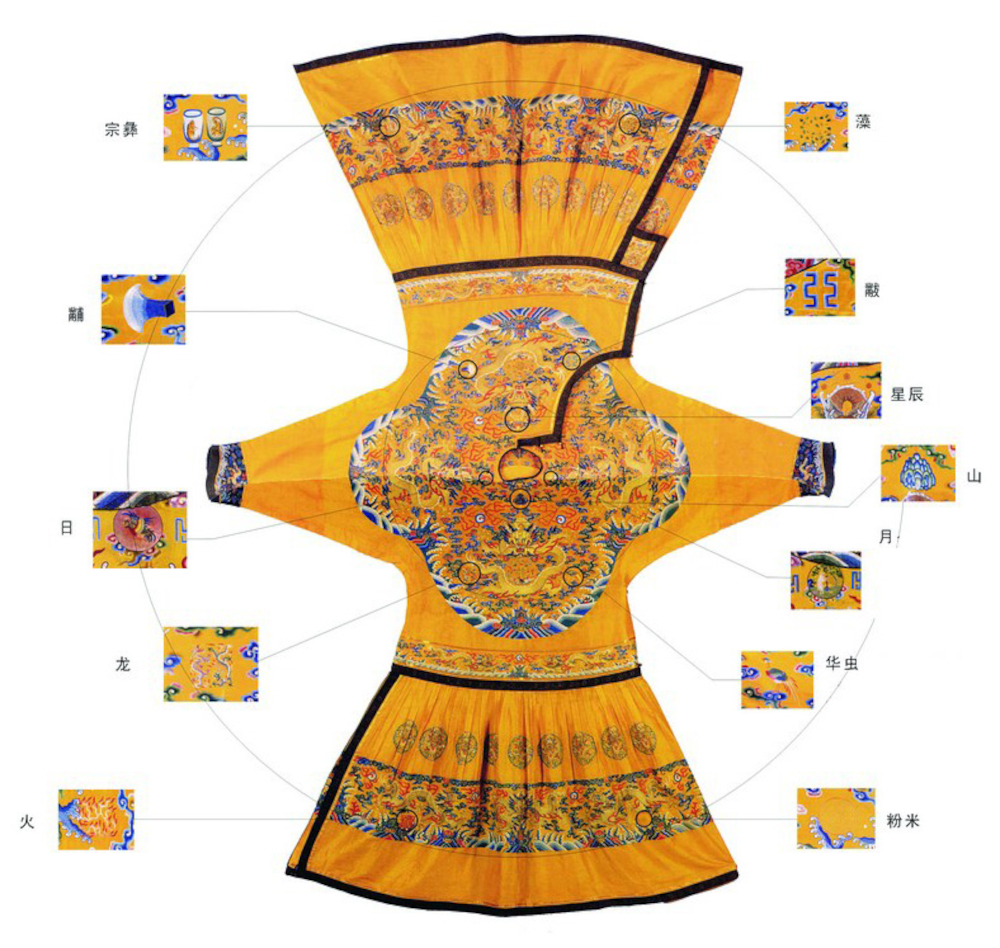Twelve Ornaments (十二章纹), Symbols of Clothing Rank during Imperial China

At first glance, they are simply patterns—sun, moon, mountains, dragons—embroidered in gold and silk on imperial robes. But in the eyes of the ancients, these were not mere decorations.
What Are the Twelve Ornaments?
In imperial China, ceremonial robes were not just clothing—they were visual declarations of authority and morality. The Twelve Ornaments (十二章纹 ; shí’èr zhāng wén), also known as Twelve Chapters (十二章 ; shí’èr zhāng) or Twelve Emblem Patterns (十二纹章 ; shí’èr wén zhāng), adorned the highest-ranking ceremonial robes worn by emperors and top officials.
The Twelve Ornaments include:

- Sun (日),
- Moon (月),
- Stars (星辰),
- Mountains (群山),
- Dragon (龙),
- Huachong (华虫)—Sometimes separated into Flower (花) and Bird (鸟),
- Zongyi (宗彝)—Before the Southern Song represented by Tiger (老虎) and Monkey (猴子),
- Waterweed (藻),
- Fire (火),
- Millet/Grain (粉米)—Before the Jin dynasty separated into Powder (粉) and Grain (米),
- Fu (黼), and
- Fu (黻).
Origin of the Twelve Ornaments
The origin of the Twelve Ornaments can be traced back to the era of Emperor Shun and was continued by later generations.
During the Zhou dynasty, Zhougong Dan (周公旦 ; Zhōugōng Dàn) established the Zhou Li (《周礼》), stipulating that the three patterns of the sun, moon, and stars were painted on flags, while ceremonial clothing retained only nine patterns, with the dragon as the first pattern, thus called “Long Gun 龙衮” (lóng gǔn, Dragon Robe).
Later, when Qin Shihuang ascended the throne, he abolished the ornament system, and ceremonial sacrificial clothing became plain black, called “Junxuan 袀玄 (jūn xuán).” It was only during the Eastern Han dynasty that the Twelve Ornament system was restored.
The Twelve Ornaments were not merely decorative motifs for imperial robes; more importantly, they symbolized the emperor’s virtues and authority. Each emblem represented a particular virtue, and together the twelve emblems formed the perfect image of the emperor. In addition, the Twelve Ornaments also reflected the feudal hierarchy: officials of different ranks had different numbers and types of ornaments on their clothing.
Symbolism of the Twelve Ornaments

- Sun (日 ; rì), Moon (月 ; yuè), Stars (星辰 ; xīng chén): Signify light; symbolize illumination.
- Mountains (群山 ; qún shān): Signify a place revered by people; symbolize stability and calmness.
- Dragon (龙 ; lóng): Signifies the ability to transform; symbolizes wonder and change.
- Huachong (华虫 ; huá chóng) — sometimes separated into Flower (花 ; huā) and Bird (鸟 ; niǎo): Signifies the beauty of the pattern (referring to its colorful appearance).
- Zongyi (宗彝 ; zōng yí) — before the Southern Song represented by Tiger (老虎 ; lǎo hǔ) and Monkey (猴子 ; hóu zǐ): Signifies loyalty and filial piety. The tiger signifies ferocity; the monkey signifies wisdom. Symbolizes offering and devotion.
- Waterweed (藻 ; zǎo): Symbolizes purity.
- Fire (火 ; huǒ): Symbolizes brightness.
- Grain (粉米 ; fěn mǐ) — before the Jin dynasty separated into Powder (粉 ; fěn) and Grain (米 ; mǐ): Signifies “feeding people” (i.e., providing nourishment); symbolizes livelihood.
- Fu (黼 ; fǔ): Signifies “cutting” (acting decisively); symbolizes decisiveness.
- Fu (黻 ; fú): Signifies “turning away from evil and toward good”; symbolizes the ability to distinguish, observe, abandon evil, and pursue good.
Together, these symbols wove an idealized portrait of the emperor, not just as a ruler but as a moral paragon.
